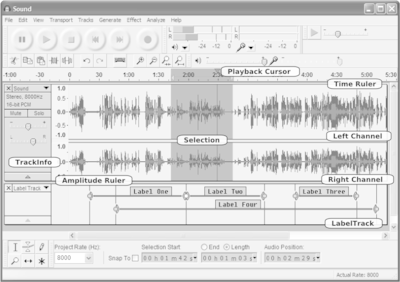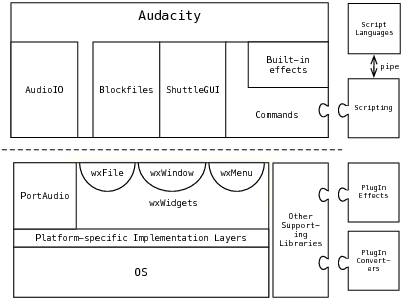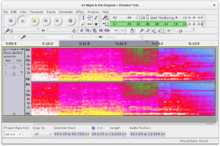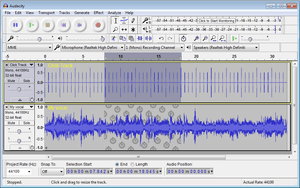Audacity (audio editor)
 | |
|
Audacity 2.1.3 | |
| Developer(s) | The Audacity Team |
|---|---|
| Initial release | May 28, 2000 |
| Stable release | 2.1.3 (17 March 2017[1]) [±] |
| Preview release | 2.2.0 alpha (March 20, 2017[2]) [±] |
| Repository |
github |
| Development status | Active |
| Written in | C, C++ (using the wxWidgets toolkit)[3][4] |
| Operating system | Windows, macOS/OS X, Linux, Unix[5][6] |
| Platform | IA-32, x86-64, PowerPC |
| Size |
64.8 MB: Windows 66.9 MB: macOS/OS X includes downloaded Manual |
| Available in |
35 languages
|
| Type | Digital audio editor |
| License | GNU GPLv2+[7] |
| Website |
audacityteam |
Audacity is a free open source digital audio editor and recording computer software application, available for Windows, OS X, Linux and other operating systems.[5][6] Audacity was started in the fall of 1999 by Dominic Mazzoni and Roger Dannenberg at Carnegie Mellon University and was released on May 28, 2000 as version 0.8.[8][9]
As of October 10, 2011, it was the 11th most popular download from SourceForge, with 76.5 million downloads.[10] Audacity won the SourceForge 2007 and 2009 Community Choice Award for Best Project for Multimedia.[11][12] In March 2015 hosting was moved to FossHub[13] and by March 20, 2017 it had exceeded 35.6 million downloads there.
Features and usage

In addition to recording audio from multiple sources, Audacity can be used for post-processing of all types of audio, including podcasts by adding effects such as normalization, trimming, and fading in and out.[15] Audacity has also been used to record and mix entire albums, such as by Tune-Yards.[16] It is also currently used in the UK OCR National Level 2 ICT course for the sound creation unit.

Audacity's features include:
- Recording and playing back sounds[17]
- Editing via cut, copy, and paste, with unlimited levels of undo[20]
- Importing and exporting of WAV, AIFF, MP3 (via the LAME encoder, downloaded separately), Ogg Vorbis, and all file formats supported by libsndfile library. Versions 1.3.2 and later supported Free Lossless Audio Codec (FLAC).[21] Version 1.3.6 and later also supported additional formats such as WMA, AAC, AMR and AC3 via the optional FFmpeg library.[22]
- Conversion of cassette tapes or records into digital tracks by splitting the audio source into multiple tracks based on silences in the source material[23]
- Multitrack mixing[24]
- A large array of digital effects and plug-ins.[25] Additional effects can be written with Nyquist, a Lisp dialect.[26]
- Built-in LADSPA, VST(32-bit) and Nyquist plug-in support[27]
- Amplitude envelope editing[28]
- Noise Reduction based on sampling the noise to be minimized.[29]
- Vocal Reduction and Isolation for the creation of karaoke tracks and isolated vocal tracks.[30]
- Audio spectrum analysis using the Fourier transform algorithm[31][32]
- Support for multi-channel modes with sampling rates up to 96 kHz with 32 bits per sample[33]
- Precise adjustments to the audio speed (tempo) while maintaining pitch in order to synchronize it with video or run for a predetermined length of time[34]
- Adjusting audio pitch while maintaining speed and adjusting audio speed while maintaining pitch[35]
- Features of modern multitrack audio software including navigation controls, zoom and single track edit, project pane and XY project navigation, non-destructive and destructive effect processing, audio file manipulation (cut, copy, paste)
- Cross-platform operation — Audacity works on Windows, macOS/OS X, and Unix-like systems (including Linux and BSD)[36]
- Audacity uses the wxWidgets software library to provide a similar graphical user interface on several different operating systems.[37]
- LADSPA, VST (32-bit) and Audio Unit (macOS/OS X]) effects now support real-time preview (from version 2.1.0 onwards). Note: Real-time preview does not yet support latency compensation.[38]
- Saving and loading of user presets for effect settings across sessions (from 2.1.0 onwards).[39]
- A full downloadable Manual[40] (or available online without downloading).
Audacity supports the LV2 open standard for plugins and can therefore load software like Calf Studio Gear.[41]
Limitations

Audacity supports only 32-bit or 64-bit VST audio effect plug-ins, depending on which architecture it was built for, but not both at the same time. It does not support instrument VST (VSTi) plugins.[42]
Audacity lacks dynamic equalizer controls and real time effects while recording.
MIDI files can only be displayed.[43]
Audacity does not natively import or export WMA, AAC, AC3 or most other proprietary or restricted file formats; rather, an optional FFmpeg library is required.[44]
There are warnings on startup when disk space is low (provided the user has not turned that warning off) and during recording the status bar shows the amount of recording time left available. If the user chooses to ignore those and runs out of disk space during editing, audio will be corrupted.[45]
Language support
In addition to English language help, the ZIP file of the downloadable Audacity software program includes help files for Afrikaans, Arabic, Basque, Bulgarian, Catalan, Chinese (simplified), Chinese (traditional), Czech, Danish, Dutch, Finnish, French, Galician, German, Greek, Hungarian, Irish, Italian, Japanese, Lithuanian, Macedonian, Norwegian (Bokmål), Polish, Portuguese, Romanian, Russian, Slovak, Slovenian, Spanish, Swedish, Turkish, Ukrainian, and Welsh in its user interface. A partial Bengali help file is also included.[46]
The Audacity website also provides tutorials in several languages.[47]
Reception
The free and open nature of Audacity has allowed it to become very popular in education, encouraging its developers to make the user interface easier for students and teachers.[48]
CNET rated Audacity 5/5 stars and called it "feature rich and flexible".[49] Preston Gralla of PC World said, "If you're interested in creating, editing, and mixing you'll want Audacity."[50] Jack Wallen of Tech Republic highlighted its features and ease-of-use.[51] Michael Muchmore of PC Magazine rated it 3.5/5 stars and said, "Though not as slick or powerful as programs from the likes of Adobe, Sony, and M-Audio, Audacity is surprisingly feature-full for free software."[52]
In The Art of Unix Programming, Eric S. Raymond says of Audacity "The central virtue of this program is that it has a superbly transparent and natural user interface, one that erects as few barriers between the user and the sound file as possible."[53]
Releases
| Version | Date[54] |
|---|---|
| 2.1.3 | 17 March 2017 |
| 2.1.2 | 20 January 2016 |
| 2.1.1 | 15 July 2015 |
| 2.1.0 | 29 March 2015 |
| 2.0.6 | 29 September 2014 |
| 2.0.5 | 21 October 2013 |
| 2.0.4 | 6 September 2013 |
| 2.0.3 | 21 January 2013 |
| 2.0.2 | 24 August 2012 |
| 2.0.1 | 29 June 2012 |
| 2.0.0 | 13 March 2012 |
| 1.3.14 | 11 December 2011 |
| 1.3.13 | 11 April 2011 |
| 1.3.12 | 1 April 2010 |
| 1.3.11 | 18 January 2010 |
| 1.3.10 | 1 December 2009 |
| 1.3.9 | 1 September 2009 |
| 1.3.8 | 17 July 2009 |
| 1.3.7 | 28 January 2009 |
| 1.3.6 | 24 October 2008 |
| 1.3.5 | 8 May 2008 |
| 1.3.4 | 13 November 2007 |
| 1.3.3 | 18 May 2007 |
| 1.3.2 | 30 October 2006 |
| 1.3.1 | 26 September 2006[55] |
| 1.3.0 | 28 November 2005[56] |
| 1.2.5 | 30 October 2006[56] |
| 1.2.4 | 28 November 2005[56] |
| 1.2.3 | 19 November 2004[56] |
| 1.2.2 | 26 August 2004[57] |
| 1.2.1 | 9 May 2004[58] |
| 1.2.0 | 3 March 2004[58] |
| 1.1.3 | 21 March 2003[58] |
| 1.1.1 | 21 November 2002[58] |
| 1.1 | 11 June 2002[58] |
| 1.0 | 11 June 2002[58] |
| 0.98 | 25 March 2002[58] |
| 0.97 | 10 October 2001[58] |
| 0.96 | 29 July 2001[58] |
| 0.95 | 26 April 2001[58] |
| 0.94 | 10 February 2001[58] |
| 0.93 | 4 December 2000[58] - Recording Added |
| 0.91 | 4 October 2000[58] - First Version Available For Download |
| 0.8 | 28 May 2000 |
Compatibility
| Audacity version | Operating system (OS) | Minimum OS version | Audacity release date |
|---|---|---|---|
| 2.1.3 | Windows (Client versions) |
XP with SSE2 CPU | 17 March 2017 |
| 2.0.6 | 2000 | 29 September 2014 | |
| 2.0.0 | 98 and ME | 13 March 2012 | |
| 2.1.2 | OS X | 10.6 | 20 January 2016 |
| 2.1.1 | 10.5 (Universal) | 15 July 2015 | |
| 2.0.6 | 10.4 (Universal) | 29 September 2014 | |
| 1.2.6a | 10.0 | 30 October 2006 | |
| 1.0.0 | Classic Mac OS | Mac OS 9 | 11 June 2002 |
See also
Literature
James Crook, Amy Brown, Greg Wilson - The Architecture of Open Source Applications - Chapter 2 Audacity, released 2012 under CC BY 3.0 (Open access).[14]
References
- ↑ "Release Notes 2.1.3". Audacity Wiki. 2017-03-17. Retrieved 2017-03-17.
- ↑ Audacity. "Audacity for Windows Nightly Builds". gaclrecords.org.uk. Audacity.
- ↑ SourceForge (July 2004). "Project of the Month July 2004 - Audacity". Archived from the original on 23 December 2008. Retrieved 2008-11-27.
- ↑ United Nations Conference on Trade and Development (2004). "E-Commerce and Development Report 2004" (PDF). Archived (PDF) from the original on 3 December 2008. Retrieved 2008-11-27.
- 1 2 "Audacity: Free Audio Editor and Recorder". audacityteam.org. Retrieved 5 January 2012.
- 1 2 "About Audacity". audacityteam.org. Retrieved 2012-02-19.
- ↑ Audacity Team. "License, and Advice for Vendors and Distributors". Archived from the original on June 20, 2015. Retrieved 2010-02-23.
- ↑ "Version 0.8: May 28, 2000" in README.txt of audacity-win-0.8.zip
- ↑ "Credits". audacityteam.org. Retrieved 2012-02-19.
- ↑ "SourceForge.net: All-Time Top Downloads". Archived from the original on 12 November 2010. Retrieved 29 October 2010.
- ↑ "SourceForge.net: 2007 Community Choice Awards". Archived from the original on 20 January 2008. Retrieved 2008-01-19.
- ↑ "SourceForge.net: 2009 Community Choice Awards". Retrieved 2012-02-04.
- ↑ FossHub.com. "Download Audacity".
- 1 2 3 James Crook (March 15, 2012). "Chapter 2. Audacity". The Architecture of Open Source Applications. Amy Brown, Greg Wilson. ISBN 978-1257638017.
- ↑ "Podcasting with Linux Command Line Tools and Audacity". Archived from the original on 18 January 2008. Retrieved 2008-01-19.
- ↑ Frere-Jones, Sasha (May 2, 2011). "World of Wonder: How Merrill Garbus left the theatre and took the stage." The New Yorker. Retrieved 2015-05-16.
- ↑ "Playing and Recording". Audacityteam.org.
- ↑ "Scrubbing and Seeking". Audacityteam.org.
- ↑ "Timer Record". Audacityteam.org.
- ↑ "Edit commands in Audacity". Audacityteam.org.
- ↑ Audacity development team (2006-10-30). "Audacity 1.3.2 a 1.2.5 released". Retrieved 2010-01-19.
- ↑ "Importing Audio". Audacityteam.org.
- ↑ "Copying tapes, LPs or MiniDiscs to CD". Audacityteam.org.
- ↑ "Audacity Tracks Menu". Audacityteam.org. Archived from the original on 2016-03-04.
- ↑ "Index of Effects, Generators and Analyzers in Audacity". Audacityteam.org.
- ↑ "Nyquist Plug-ins Reference". Audacityteam.org.
- ↑ Audacity development team . "Audacity: Plug-ins and Libraries".
- ↑ "Audacity's Envelope Tool". Audacityteam.org.
- ↑ "Noise Reduction". Audacityteam.org.
- ↑ "Vocal Reduction and Isolation". Audacityteam.org.
- ↑ "Plot Spectrum". Audacityteam.org.
- ↑ "Audacity's Spectrogram View". Audacityteam.org.
- ↑ "Multichannel Recording". Audacityteam.org.
- ↑ "Change Tempo". Audacityteam.org.
- ↑ "Change Pitch". Audacityteam.org.
- ↑ "Cross-platform downloads for Audacity". Audacityteam.org.
- ↑ "wxWidgets Cross-platform GUI Library". Audacityteam.org.
- ↑ "Real-time preview of effects". Audacityteam.org.
- ↑ "Manage Effects, Generators and Analyzers". Audacityteam.org.
- ↑ "Audacity Manual". Audacityteam.org.
- ↑ "Calf Studio Gear supports LV2".
- ↑ "FAQ:How do I install VST plug-ins? - Audacity Manual". Audacityteam.org. Retrieved 2013-08-09.
- ↑ "FAQ Why can’t I play MIDI files?". Audacityteam.org. Retrieved 2009-12-16.
- ↑ "Audacity: Features". audacityteam.org. 2013-03-22. Retrieved 2013-09-08.
- ↑ "Release Notes 2.1.2 - Audacity Wiki".
- ↑ "Changing the current language - Audacity Wiki". Wiki.audacityteam.org. 2013-01-04. Retrieved 2013-09-08.
- ↑ "Languages page in the Audacity Manual".
- ↑ Jaworski, Nick; Thibeault, Matthew D. (2011). "Technology for Teaching: Audacity. Free and open-source software.". Music Educators Journal. 98 (2): 39–40. ISSN 0027-4321. doi:10.1177/0027432111428745.
- ↑ "Audacity". CNET. 2008-11-08. Retrieved 2013-09-01.
- ↑ Gralla, Preston (2008-10-22). "Audacity". PC World. Retrieved 2013-09-01.
- ↑ Wallen, Jack (2011-07-18). "Giving Audacity its due: An audio editor with serious functionality". Tech Republic. Retrieved 2013-09-01.
- ↑ Muchmore, Michael (2010-02-05). "Audacity 1.2 review". Retrieved 2013-09-01.
- ↑ "Studying Cases Chapter 6. Transparency".
- ↑ "Release Notes - Audacity Wiki". wiki.audacityteam.org. Retrieved 2016-04-06.
- ↑ "RPM PCLinuxOS audacity-alsa 1.3.1 i586 rpm". rpm.pbone.net. Retrieved 2016-04-07.
- 1 2 3 4 "News | Audacity®". www.audacityteam.org. Retrieved 2016-04-07.
- ↑ "Audacity / News". sourceforge.net. Retrieved 2016-04-07.
- 1 2 3 4 5 6 7 8 9 10 11 12 13 "Audacity / News". sourceforge.net. Retrieved 2016-04-07.
- Notes
- Franklin, Jerry (2006). "The Sheer Audacity: How to Get More, in Less Time, from the Audacity Digital Audio Editing Software": 92–105. doi:10.1109/IPCC.2006.320394.
- Mazzoni, Dominic; Dannenberg, Roger B. (2002). "A Fast Data Structure for Disk-Based Audio Editing". Computer Music Journal. 26 (2): 62–76. ISSN 0148-9267. doi:10.1162/014892602760137185.
- Bernardini, Nicola; Rocchesso, Davide (2002). "Making Sounds with Numbers: A Tutorial on Music Software Dedicated to Digital Audio". Journal of New Music Research. 31 (2): 141–151. ISSN 0929-8215. doi:10.1076/jnmr.31.2.141.8089.
